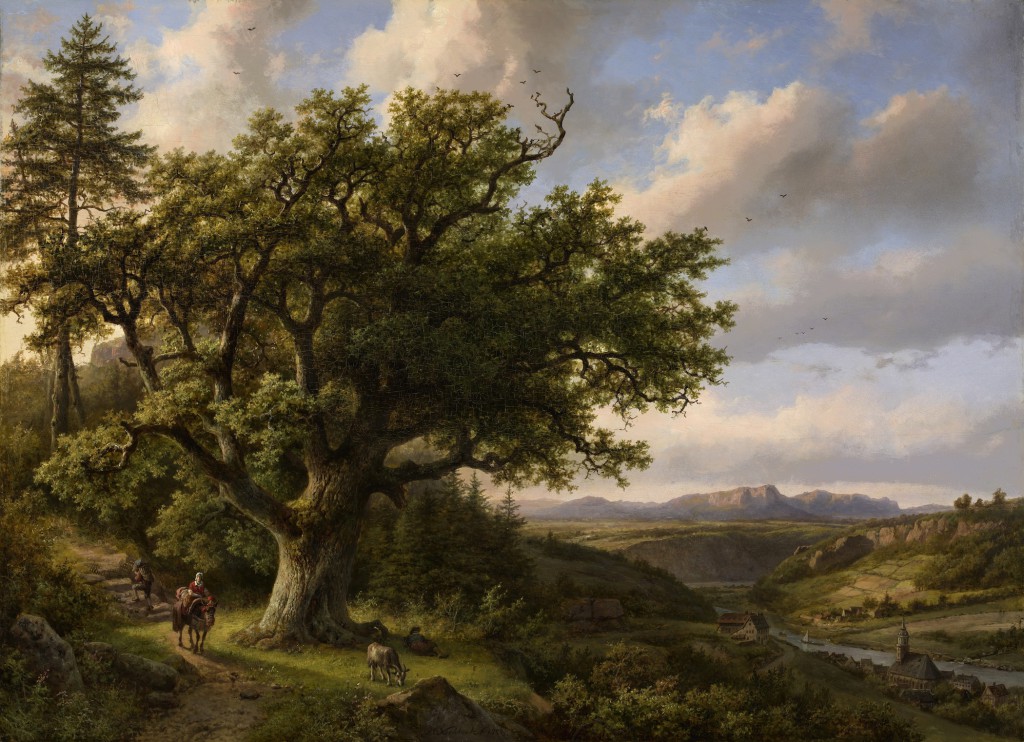Barend Cornelis Koekkoek (Middelburg 1803 - 1862 Cleves)
View of Königstein on the Elbe, 1858
Oil on panel, 57.8 x 79.6 cm
Signed and dated lower centre B C Koekkoek 1858
Provenance:
B.C. Schneiders van Greyffenswerth, Amsterdam
Vincent van Gogh, Princenhage, 1873
Auction Sale (C.F. Roos), Amsterdam, 16 October 1873, lot 34
J.H. de Souza, 1889
Auction Sale (C.M. van Gogh & H.G. Tersteeg), The Hague, 2-3 April 1889, illus.
Private collection, Germany (since 1889)
Literature:
Friedrich Gorissen, B.C. Koekkoek 1803-1862. Werkverzeichnis der Gemälde, Düsseldorf 1962, fig. 58/60
Barend Cornelis Koekkoek is generally regarded as the leading landscape painter of the Dutch Romantic period. He received commissions from King Willem II of the Netherlands, Tsar Alexander II of Russia and Friedrich Wilhelm IV of Prussia.
He was born in Middelburg in 1803. He trained under his father, the renowned marine painter Johannes Hermanus Koekkoek (1778-1851), the founder of the Koekkoek dynasty of painters. He received a bursary from the Dutch crown that enabled him to study at the Royal Academy of Fine Arts in Amsterdam. He embarked on his studies in 1821 under Jan Willem Pieneman (1779-1853) and Jean Augustin Daiwaille (1786-1850). He married Daiwalle's daughter Elise Thérèse in 1833. He travelled extensively, visiting the Harz Mountains, the Rhineland and Italy. It was his enthusiasm for the landscapes of the Rhine that persuaded him to settle in the German town of Cleves in 1834. He founded a drawing academy (das Zeichen-Collegium) in Cleves in 1841. His handbook for students of landscape painting was published in 1841 under the title Erinnerungen und Mitteilungen eines Landschaftsmalers. The publication greatly contributed to his burgeoning reputation.
The popularity of his work in the 1850s barely allowed him time for study trips but he travelled in Saxony in 1857.[1] The present View of Königstein on the Elbe, executed in 1858, was clearly inspired by what he saw on this journey. Gorissen records a related drawing in blue and brown wash titled Königstein in Saxony and dated 1857.[2]
The town of Königstein lies on a sweeping bend of the Elbe south of Dresden. The landscape is dominated by sandstone crags and towering cliffs - the Elbsandsteingebirge - on the edge of what is now a national park, the Sächsische Schweiz, or 'Saxon Switzerland'. Mid-nineteenth century Königstein with its historic hilltop fortress developed into something of a tourist attraction after the introduction of steam shipping on the Elbe in 1837 and the construction of a railway line in 1851.
View of Königstein on the Elbe demonstrates Koekkoek's mastery of the landscape genre. In its precision and attention to detail it is without doubt one of the finest works he produced in the 1850s. The monumental oak depicted on the slope in the left foreground is something of a trademark in his work, a much-admired device that recurs in many of his paintings. To the right, the eye is drawn to an expansive landscape showing the Elbe valley and the crags and cliffs of the Sächsische Schweiz. On the horizon are the outlines of two of its peaks, the Kleiner Bärenstein and the Grosser Bärenstein. The painting depicts an idyllic image of the landscape - an idealized view of nature in its intactness and immensity. Far below to the right, Königstein city church is glimpsed, and on the narrow ribbon of the river at its left, the tiny forms of the Elbkähne, the traditional Elbe sailing barges. On the opposite bank is the hamlet of Halbestadt.
A severe stroke in November 1859 put an abrupt end to his career as a painter.[3] He died in Cleves in 1862 and his home and atelier now house a museum, the Museum Haus Koekkoek.
Koekkoek, who was described as the 'prince of landscape painting', received numerous awards and on three occasions a Gold Medal at the Paris Salon. He was also awarded the Légion d'honneur and the Leopoldsorden. Shortly before his death he was named a member of the Academy of St. Petersburg and represented the Netherlands posthumously at the London International Exhibition of 1862.
[1] See Angelika Nollert, Barend Cornelis Koekkoek, 1803-1862: ein Landschaftsmaler der niederländischen Romantik, Frankfurt a.M. (et al.) 2000, p. 36.
[2] Friedrich Gorissen, B.C. Koekkoek 1803-1862. Werkverzeichnis der Gemälde, Düsseldorf 1962, Z 57/41,2.
[3] Koekkoek's last dated paintings were, like the present painting, executed in 1858. Only one bears the date 1861 (after his stroke).

